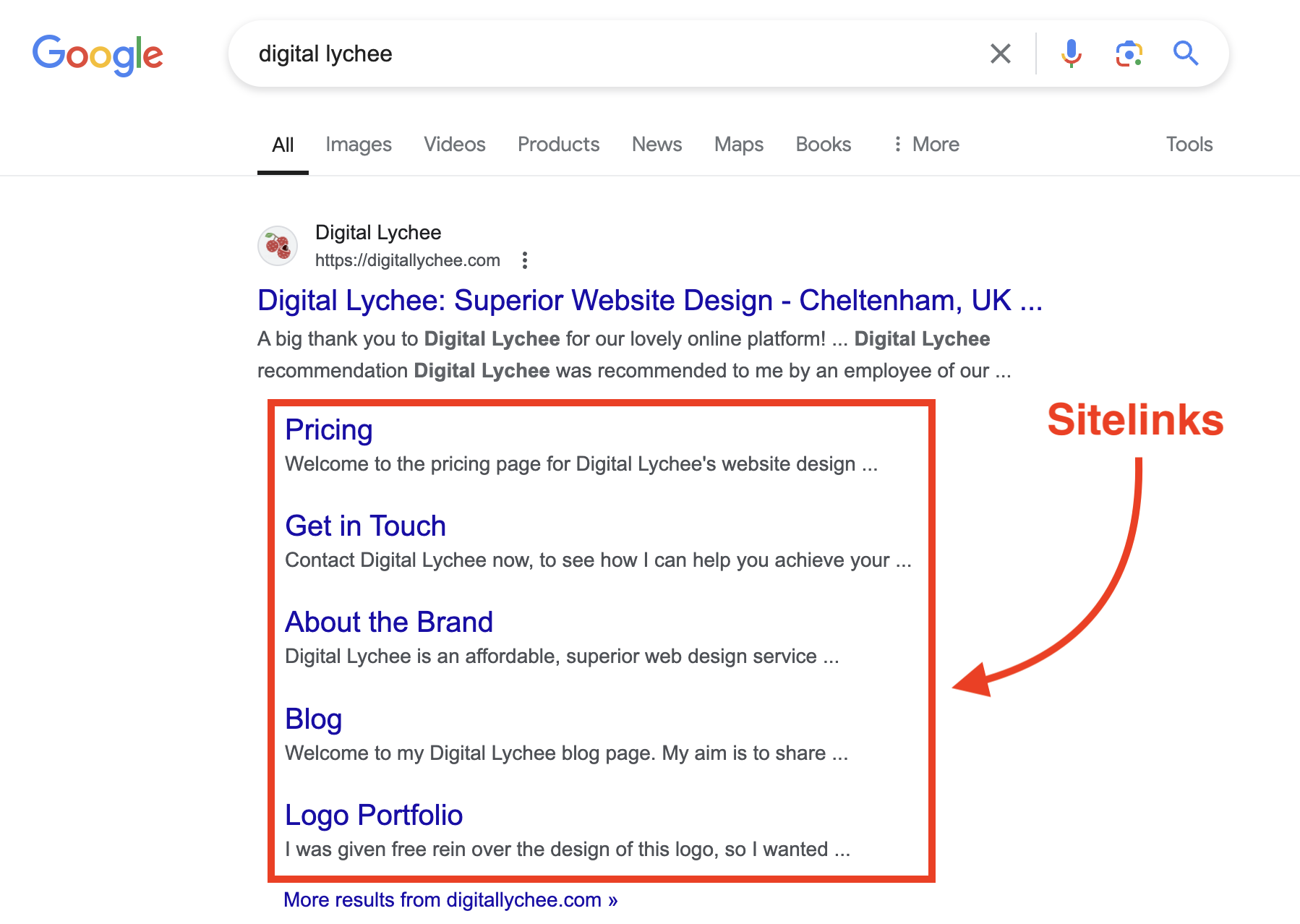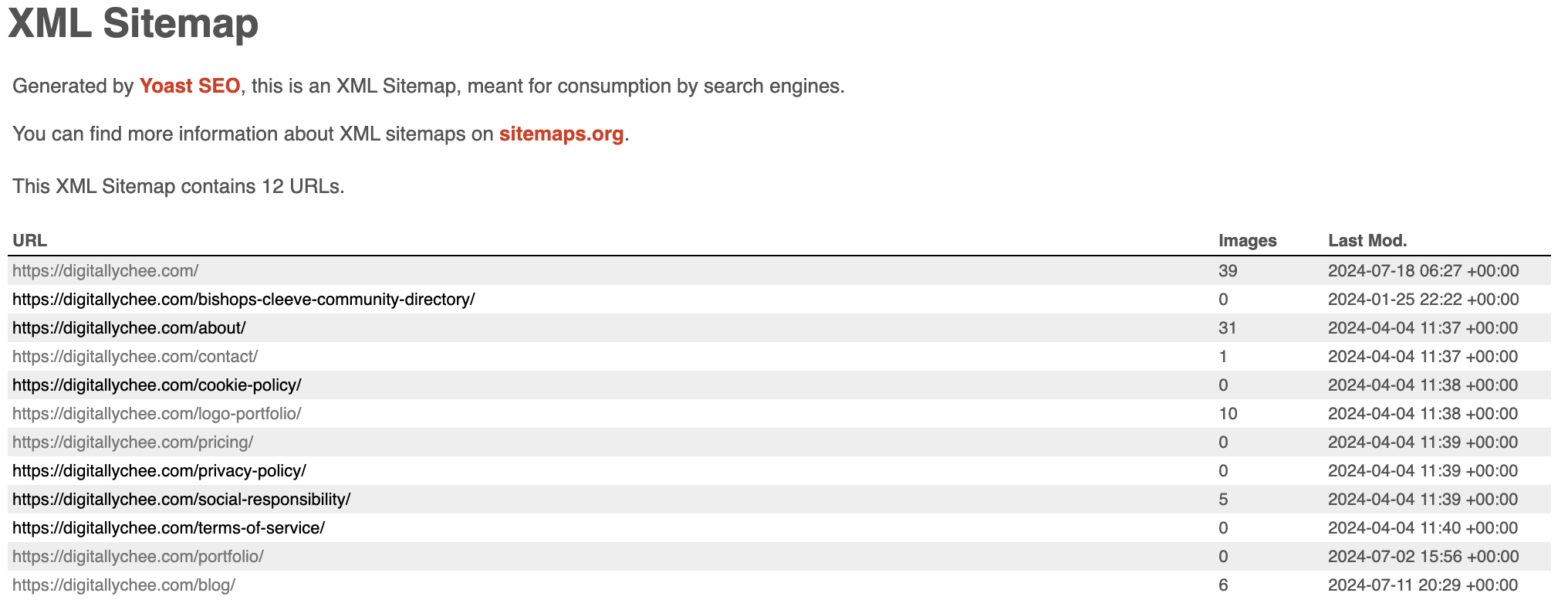Have you ever been searching for something on Google and you’ve noticed that at the top of the search results, there’s a website that has a number of links below it, ‘sub links’, to other pages on the site? Well, these are known as ‘sitelinks’. In this blog, I’ll explain what they are, why they’re significant and you should care about them, and finally how to actually create them for your site.
Sitelinks: What are they?
Sitelinks themselves are the little ‘sub-links’ that appear under the main search result for a given search result. They are links from the same domain, grouped together under the main result. Their aim is to help your website’s visitors navigate around your site more easily. According to Google:
“Our systems analyze the link structure of your site to find shortcuts that will save users time and allow them to quickly find the information they’re looking for. We only show sitelinks for results when we think they’ll be useful to the user.”

Why are they important?
As Google has suggested, quoted above, the sitelinks they generate will help users to navigate your site more effectively, helping them to save time, allowing them to find the information they need from your site much more easily. They also help to build trust with your website visitors, since when people see them, your site is appearing at the top for a search the user made and therefore the implication is that you are the best at what you do.
Aside from building trust with your website’s visitors and helping to send more traffic to the internal pages of your site, they will help to:
- Improve your site’s CTR, or click-through rate, which is the number of clicks your site’s links receive, divided by the number of times your link is shown. This is because having sitelinks means your site is much more prominent in search rankings and so they are more likely to be clicked on.
- Establish an improved, or very good brand reputation. When a user sees your site at the top of search rankings for their search, and they see all the sitelinks offered by Google for your website, then instantly this will be seen as very positive by the user, giving the impression that you are the best at what you do, improving your reputation.
- Cover more SERP (search engine results page) space. When your website has sitelinks in search results, by simple virtue of their presence, you take up much more space on the search results page, which means there’s less space for your competitors, leaving you with a much greater chance of the user clicking through to your site and ultimately using your services.
How do you generate sitelinks for your website?
Although we know how important they can be for your website, unfortunately there is no direct way to create them. As Google has said:
“We only show sitelinks for results when we think they’ll be useful to the user. If the structure of your site doesn’t allow our algorithms to find good sitelinks, or we don’t think that the sitelinks for your site are relevant for the user’s query, we won’t show them.”
What this means is that we can’t do anything to guarantee that they are shown, or click any sort of a button to ensure they show when your website appears in search results. However, whilst we can’t guarantee their presence, there are a number of things we can do to improve your chances of them showing, including:
#1: Write Informative & Relevant Page Titles
The first and perhaps most important thing that you can do for your website is to make sure that any text you use for the page headers is informative, relevant and compact. Avoid irrelevant and overly-long page titles, keyword stuffing and repetitive wording. For example, if a heating engineer were to create a page that gave information about landlords and gas safety certificates, a good title would be:
Landlord Gas Safety Certificates
and a poor one would be
Landlord Gas Heating Engineer Safety Certificate Legal Requirements
The former is clear and concise, making the page subject obvious, in a human-readable way. The latter is very long and just has lots of key words in it, which in the end, results in the title not making much sense. You want to ensure that your page titles are more like the first choice here.
Furthermore, you need to ensure that each of your page titles have the correct HTML tags, so that Google can identify them as such. Page titles and sub-titles much have the following HTML tags:
- h1: The title of each of your pages must have this HTML tag.
- h2: Any sub-titles must have this HTML tag.
- h3: Any sub-sub-titles must have this HTML tag.
You can see the pattern. The lower the ‘sub’ level of your page or section title, the higher the ‘h’ number. If there is no h1 tag present on a page, then Google won’t know what the title is and therefore won’t show sitelinks. Equally, there should never be more than one h1 tag, as this can confuse Google as to what the page title actually is. h1 is essentially the top of the pyramid, so you can only have one of them, but you can have multiple h2 and h3 tags etc.
#2: Create a Logical Site Structure
If your websites have a clear navigational structure, it makes things significantly easier for Google (and Bing) when they crawl your site. The easier it is for them to do so, the better the chance you have of sitelinks being generated. If Google can easily find all the pages on your site and can understand how they all relate to each other, then this is a big plus.
Your homepage is without a doubt always going to be the most visited page on your site. All other pages on your site should be ‘child’ pages, sat beneath the homepage. For example, if you are a beautician and have three different services, such as Hair, Nails and Eyebrows, you could organise your page structure for one of them like so:
Homepage > Services > Hair
#3: Use Effective Link Placement
This is easy to overlook. However, it is vitally important that you ensure from any given page on your website, you link to other relevant and important pages on your site, without fail.
If you look at the sitelinks for a website at the top of search results for any given search, you will see that the links also appear in prominent places on the site. If we take the example from a search for Digital Lychee above, every single one of the sitelinks you see appears in the main navigation bar on the site, as well as also the menu in the footer.
#4: Create and Update an XML Sitemap
If you are not familiar with the concept, an XML sitemap is an XML-formatted document available on your website, which contains information about each page, including some/all of the following:
- The page URL
- The number of images on the page
- A timestamp showing the date and time the page was last modified
It will usually be named sitemap.xml, page-sitemap.xml or something similar. For example, the page sitemap for Digital Lychee has the following URL:
https://digitallychee.com/page-sitemap.xml
And it looks like this:

Depending on the platform your website uses, then this might be automatically generated for you. If not, you will have to ensure one is created for you. For example, my own website is built with WordPress and makes use of the Yoast SEO plugin. This plugin automatically generates the sitemap for my site and keeps it up-to-date whenever anything changes. Once created, you must ensure that it is submitted to the Google Search Console and Bing Webmaster Tools. This means the page structure on your site will be clear to the search engines and gives you a greater chance of sitelinks showing.
#5: Create Relevant Page Metadata
Whenever you create a page and give it a title & content, you also need to make sure that you set the metadata correctly. By this point we have already seen the importance of a properly-written page title. You also need to make sure that you have set the SEO/meta description correctly, which is what appears underneath the SEO/meta title in search results.
If your page description includes the same, relevant and un-repeated key words as your title, this will help to improve how Google views your page and will improve the CTR (click-through rate) for the page, which will in turn give you a greater chance of having a sitelink appearing for that page.
#6: Avoid Repetitive Content
When you write the copy for your page, you of course want to make it as informative and helpful as possible for your visitors. However you need to be careful that in doing so, you don’t repeat yourself. The less you repeat yourself, the more concise your website’s copy is and this is one of the factors that search engines will look at when deciding where to rank your page in search results and whether or not to show it as a sitelink to your main page.
So, what can we conclude?
Throughout this article, we have seen how we can optimise your website, to give you the best possible chance of it appearing at the top of the search rankings, with sitelinks underneath. However, sadly, nothing that you do with your site is a guarantee that sitelinks will appear.
Always make sure you follow the guidance in this article. If nothing else, this will still help to improve traffic to your website, as well as your brand reputation. Over time, you may very well notice that sitelinks do indeed start to appear for your website in search results.
How will Digital Lychee Help You?
At Digital Lychee, I make sure that I tailor all my clients’ websites to suit their individual needs. In your initial consultation (free and no obligation, of course) we will discuss your needs in full and I can advise you on how best to create your logo (and other images) to make sure they are as sharp as possible on all possible devices. If you are interested in my services, or you want to find out more about my blog, I would love to hear from you. You can get in touch with me here.
